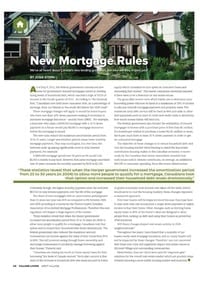We’ve all heard about Canada’s new lending guidelines, but how will they impact you?

As of July 9, 2012, the federal government introduced new rules for government insured mortgages aimed at slowing rising levels of household debt, which reached a high of 152% of income in the fourth quarter of 2011. According to the National Post, “Canadians now hold more consumer debt, as a percentage of earnings, than our friends to the south did before the 2008 crash”.
These mortgage channels will apply to would-be home buyers who have less than 20% down payment making it necessary to purchase mortgage insurance – usually from CMHC. For example, a borrower who takes a $400,000 mortgage with a 10% down payment on a house would pay $8,640 in mortgage insurance before the mortgage is issued.
The new rules reduce the maximum amortization period from 30 to 25 years. Longer amortization periods mean lower monthly mortgage payments. That may sound good, but over time, the borrower ends up paying significantly more in total interest payments. For example:
A $400,000 mortgage spread over 30 years at 4% would cost $1,902 a month to pay back. However, the same mortgage amortized over 25 years increases the monthly payment by $202 to $2,104. Ultimately though, the higher monthly payment saves the borrower $53,522 in total interest payments over the life of the mortgage.
The share of new mortgages with an amortization period greater than 25 years last year was 41% as compared to 8% between 2000 and 2005 according to a survey by the Toronto-based Canadian Association of Accredited Mortgage Professionals. Therefore this new regulation will impact a large segment of the market.
These statistics reveal that when the Harper government increased the amortization period from 25 to 30 years (in 2006) to allow more people to qualify for a mortgage, Canadians took that option and increased their household debt levels dramatically. The federal government also reduced the maximum amount homeowners can borrow against the value of their home from 85% to 80%. This will promote saving through home ownership and encourage homeowners to prudently manage borrowing against their homes,” Flaherty said.
“Canadians are relying too much on home equity loans for their borrowing” the Bank of Canada warned. “Particular concern is that most of the increase in household debt was loans secured by home equity which Canadians in turn spent on consumer items and renovating their homes”. This leaves consumers extremely exposed if there were to be a downturn in real estate values.
The gross debt service ratio which banks use to determine your borrowing power will now be fixed at a maximum of 39% of income to allocate towards mortgage payment and property taxes. The maximum total debt service will be fixed at 44% and adds in other debt payments such as lines of credit and credit cards to determine how much money banks will lend you.
The federal government also limited the availability of insured mortgages to homes with a purchase price of less than $1-million. If a homebuyer wishes to purchase a home for $1 million or more, the buyer must have at least 20 % down payment in order to get an uninsured mortgage.
The objective of these changes is to reduce household debt and cool the housing market while bearing in mind the important contribution housing makes to the Canadian economy. A recent study by the Canadian Real Estate Association revealed that each house sold in Ontario contributes, on average, an additional $40,350 in consumer spending. Since the recent deterioration of global economies took interest rate hikes off the table (which would serve to cool the housing market), these changes represent a measured approach.
First time buyers will be impacted most because they may have to wait until they can accumulate a larger down payment or higher income to buy their home. Other changes, such as limiting home equity loans to 80% of the home’s value are designed to deter people from racking up debt and using their homes as proverbial ATM machines.
Will these changes impact real estate activity in OUR neighbourhoods?
Throughout the years I have found that a majority of our buyers are financially responsible, rarely need mortgage insurance, and so, many buyers will not be impacted by these changes. Therefore I am not overly concerned that these new rules will negatively impact real estate values in Hillcrest Village and surrounding communities in the long term.
Nevertheless, they are “short term pain for long term gain” solutions for the overall real estate market which are prudent steps towards ensuring a more stable housing market and economy.
by Josie Stern
Originally printed in Village Living Magazine.